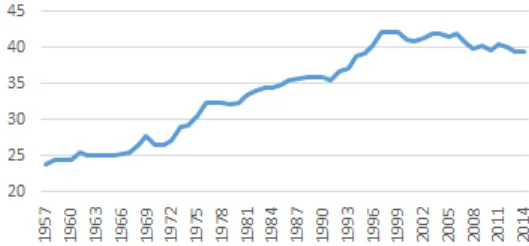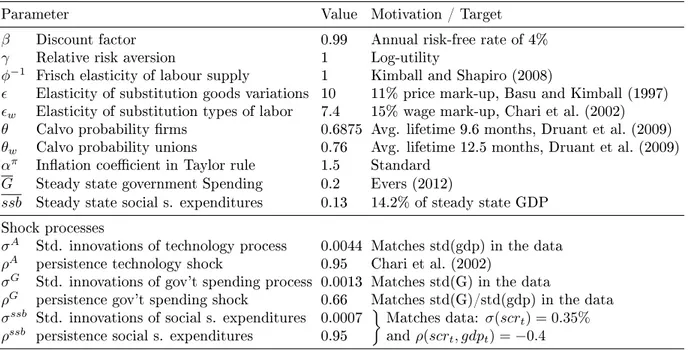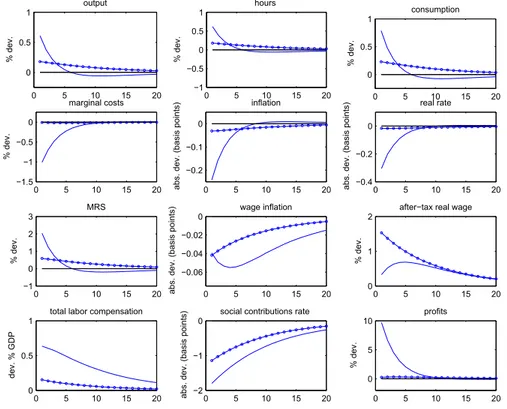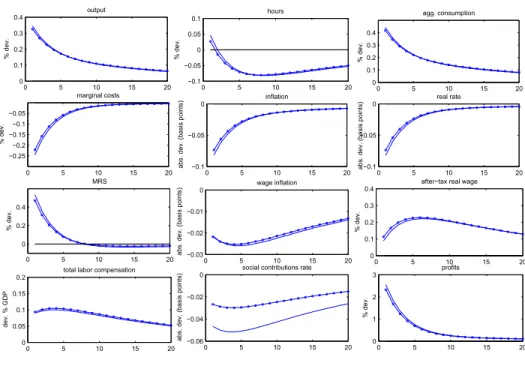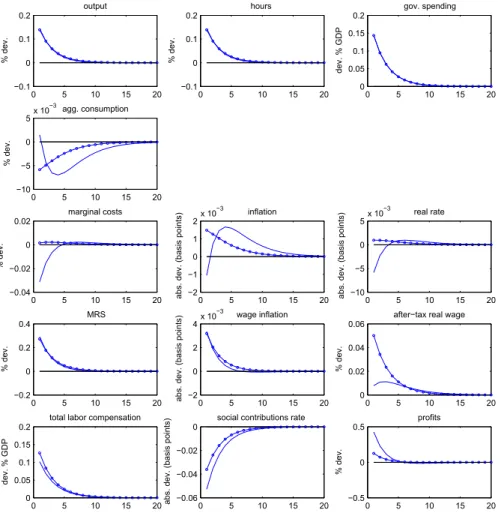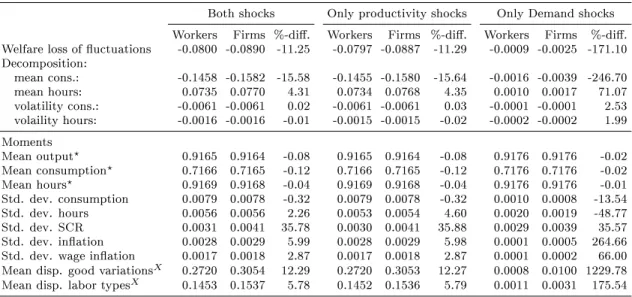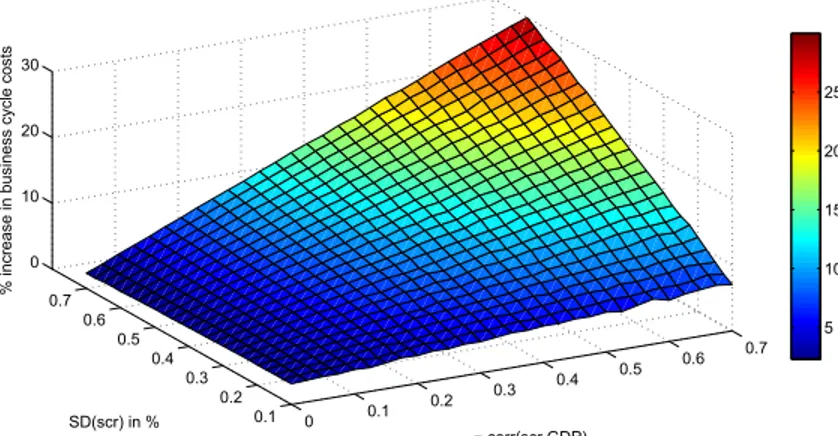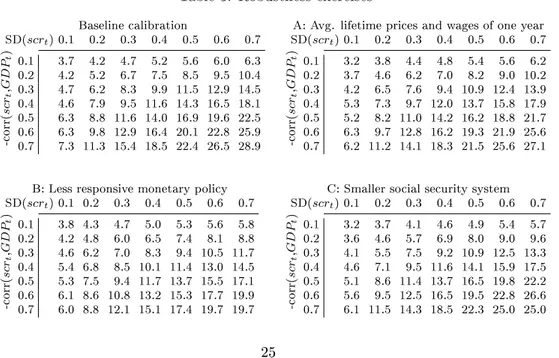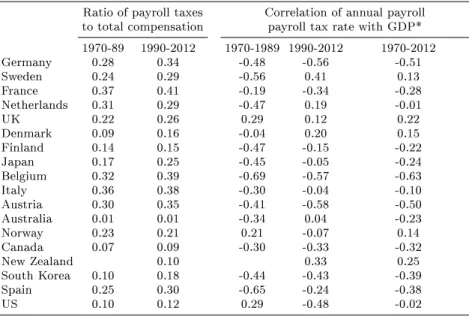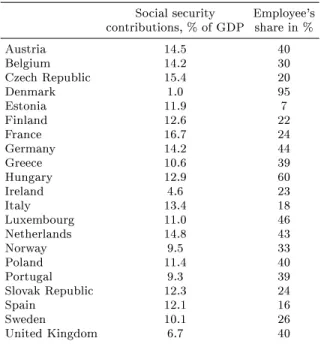S F B
XXX
E C O N O M I C
R I S K
B E R L I N
SFB 649 Discussion Paper 2014-061
A Macroeconomic Perspective on the
Equivalence of Taxes Paid by Employers and
Employees Simon Voigts*
* Humboldt-Universität zu Berlin, Germany
This research was supported by the Deutsche
Forschungsgemeinschaft through the SFB 649 "Economic Risk".
http://sfb649.wiwi.hu-berlin.de ISSN 1860-5664
SFB
6 4 9
E C O N O M I C
R I S K
B E R L I N
A Macroeconomic Perspective on the Equivalence of Taxes Paid by Employers and
Employees
Simon Voigts January 7, 2015
Abstract
Conventional wisdom states that the statutory split of labor taxes be- tween rms and workers is of no macroeconomic relevance, because the tax incidence is fully determined by the market structure. This paper breaks with this view by establishing a theoretical link between the lia- bility side of labor taxes and the business cycle volatility of prices and wages. It is shown that funding a social security system by a wage tax (paid by workers) signicantly reduces the volatility in nominal variables relative to the volatility under a payroll tax (paid by rms). The gain in price and wage stability reduces ineciencies in the equilibrium allocation of the stochastic model and thereby welfare costs of business cycle uc- tuations. In a standard DSGE model calibrated for a European country, switching the liability side reduces welfare costs by 11.25%. Since the long-run income distribution is not aected, the nding points out room for Pareto improvement.
JEL classication: H55, H21, E30, E32, E60, D02.
Keywords: Labor taxes, social security, business cycles, automatic stabilizers, optimal taxation, liability side equivalence.
Humboldt-Universität zu Berlin, School of Business and Economics, Spandauer Straÿe 1, 10178 Berlin, Germany, email: s.voigts@hu-berlin.de. This research was supported by the Deutsche Forschungsgemeinschaft through the CRC 649 'Economic Risk'. I thank Michael Burda, Philipp Engler, Falk Mazelis, Alexander Meyer-Gohde and Julia Otten for useful comments as well as Anna Almosova for excellent research assistance.
1 Introduction
Economists have long understood that under price exibility, the burden of a transaction tax will be shared according to the price elasticities of demand and supply. This insight, going back to Dalton (1922), is known as liquidity-side- equivalence (LSE) and is a standard component of economic training. In the context of the labor market, LSE implies that the liability side of a tax on labor is of no consequence for the distribution of the tax burden between employer and employees. Hence it does not matter to which share a tax is levied on the side of workers (as a 'wage tax') and on the side of rms (as a 'payroll tax'). This conclusion has been challenged from dierent perspectives. In labor economics, there is a strand of literature that examines whether LSE holds in the presence of market imperfections, i.e. in the context of eciency-wage and wage-bargaining models (see, among others, Picard and Toulemonde (2001), Rasmussen (1998) or Koskela and Schöb (1999)). Regarding empirical work, Lehmann et al. (2011) test for LSE in a non-experimental setup, while Weber and Schram (2013) conduct a laboratory experiment to analyze the implications of the liability side arising from bounded rationality.
This paper is the rst to approach LSE of labor taxation from a general equilibrium perspective. Using a standard quantitative business cycle model, it establishes a link between the liability side of social security contributions (levied as a tax on labor) and welfare costs of business cycle uctuations. This nding does not challenge the validity of LSE itself, since LSE holds in the model to the extend that prices and wages adjust. However, the nding contributes that, although the liability side is neutral for the distribution of the tax burden, it is not neutral for business cycle uctuations. That is, the result does not challenge LSE in the 'classical sense', but it shows that the liability side of labor taxation is non-neutral in the broader sense that it matters for macroeconomic stability.
Establishing this role of the liability side of social security contributions relates the paper to two further strands of literature. The presented link is of relevance to the literature on public nance, as it points out a novel aspect of the design of labor taxation. Regarding the literature on automatic stabilizers, this paper contributes that the liability side matters for the degree of passive stabilization provided by the system. This literature fully neglects this design dimension and focuses on how taxes and transfers cushion disposable income over the cycle.1
The theoretical nding of this paper states that if social contributions are levied as wage tax, business cycle volatility in nominal variables is lower relative to the volatility under the use of a payroll tax. As a result, welfare costs of business cycle uctuations are lower if the system is funded by a wage tax.
Quantitatively, a full shift of labor taxation from rms to workers reduces welfare costs by 11.25% in a standard New Keynesian business cycle model calibrated to a typical European country with a sizable welfare system.
1See Furceri (2010) for a recent overview.
Before sketching the mechanism behind this result, I discuss the only non- standard assumption it requires. The nding rests on the assumption that the social contributions rate (SCR) is subject to adjustments in response to distur- bances in the macroeconomic environment. These adjustments can have two dierent causes in the model. The rst cause are uctuations in outows of the social system, to the extent that these uctuations aect its nancing needs and trigger adjustments in social security revenues that are implemented by chang- ing the SCR. Cyclicality of outows, especially from unemployment insurance schemes, is a standard result in the literature on automatic stabilizers. The second cause for adjustments in the SCR are uctuations in total labor com- pensation, which is the tax base of social contributions levied as a tax on labor.
If the SCR was not adjusted, cyclical movements in total labor compensation would translate into uctuations in social security revenues. A government that seeks to maintain a given level of revenues therefore has to adjust the SCR to oset changes in the tax base. As a rst assessment of the empirical plausibility of this assumption, the following graph shows the evolution of the statutory SCR in Germany. The mean deviation from the HP-ltered series amounts to 0.34%2, which is shown to be sucient to generate signicant welfare implications of the liability side.
Figure 1: German statutory social contributions rate
Turning to the intuition of the result, I rst establish that shifting the liabil- ity side from rms to workers implies that the change in the SCR that is required to bring about a given adjustment in revenues becomes smaller in magnitude.
Since LSE holds in the model, shifting the taxation towards workers implies an increase of pre-tax wages in compensation of the additional nominal tax bur- den. In the aggregate, this implies a rise in (pre-tax) total labor compensation.
The key insight is that if total labor compensation is higher, a given change in revenues (the product of tax base and tax rate) requires a smaller change in the SCR.This observation intuitively implies that the volatility in the SCR required to bring about a given stochastic pattern of revenue adjustments becomes smaller.
That is, adjusting revenues can be by achieved with a more stable SCR if the system is funded by a wage tax. This implies a reduction in welfare costs of busi- ness cycle uctuations, because it lowers the volatility in nominal variables and
2The smoothing parameterλ = 6.25was applied as in Burda and Weder (2014). Data source: The German Council of Economic Experts.
thereby the degree of ineciencies in the equilibrium allocation associated with price and wage dispersion. The reason why a more stable SCR implies more sta- ble prices and wages is that changes in the SCR trigger nominal re-adjustments.
Levied on the side of workers, changes in the SCR move after-tax real wages and thereby cause adjustments in nominal wages. On the side of rms, variations in the SCR move eective marginal costs and trigger price adjustments. It is well known that price and wage volatility contributes to the welfare costs of business cycle uctuations. As e.g. described in Woodford (2003), nominal adjustments are associated with price and wage dispersion, which induces a resource cost as it lowers the eciency of the equilibrium allocation. Hence, inducing a more stable SCR reduces nominal volatility and thereby the eciency loss from this source, implying a reduction of the welfare costs of business cycle uctuations.
Regarding the policy relevance of the nding, two remarks are in order. The rst is that the mechanism presented in this paper is disconnected from the well understood Keynesian-type stabilization provided by social security systems.
As the liability side does not aect the amount of generated revenues, it is neutral to the general nancial stance of the system and thereby neutral to the means of the social system to stabilize income over the cycle. The liability side therefore constitutes a political control variable that is not in conict with this desirable property of the welfare system. The second remark is that the liability side has, due to LSE, no long-run implications for the average ratio between prots and labor income. Hence, if a one-time shift of the statutory taxation towards workers is accompanied by a compensating rise in nominal wages, it is fully neutral to the income distribution in the economy. In this case changing the liability side induces a Pareto improvement, as it does not entail redistribution but all households benet from the induced eciency gain.
Only then is it desirable from the perspective of the author. Since the statutory contribution to social security paid by workers is below 50% in vast majority of OECD countries, the ndings imply substantial room for Pareto improvements.3 Section 2 lays out the model and discusses the calibration. Section 3 and 4 explain the ndings in detail. Welfare results and robustness checks are reported in section 5, and the paper concludes with section 6.
2 The model
This paper employs a standard closed-economy New Keynesian DSGE model.
The economy is populated by a continuum of rms and a continuum of innitely- lived households. Firms produce dierentiated intermediate goods, which are aggregated into a nal goods bundle consumed by households. Likewise, house- holds supply dierentiated types of labor, which enter the production function subject to aggregation into a composite of labor services. Price and wage set- ting is staggered by Calvo mechanisms. The model features a social security system which is nanced by a wage tax and/or a payroll tax, i.e. by a labor
3Table 5 in the appendix reports the statutory split for 21 OECD countries. From this sample, 19 countries have a statutory share of workers of below 50%.
tax that is levied on the side of workers and/or rms. Revenues are reimbursed as lump-sum transfers to households. A government consumes according to an exogenous process, with public consumption dened as plain waste. Its expen- ditures are fully nanced by lump-sum taxes in every period. Monetary policy is governed by a standard Taylor rule. There are two sources of uncertainty in the economy: Productivity shocks entering the production technology and demand shocks entering government spending. The remainder of this section presents the dierent building blocks of the model as well as its calibration.
2.1 Households
Each household on the continuum is indexed byj∈[0,1], but the index is sup- pressed in this section for ease of notation. Households choose consumption as to maximize their expected life-time utility. Hours worked are determined by la- bor demand because households reduce their labor supply below the competitive level to make use of their market power.
Life-time utility is given by:
Ut=Et
∞
X
k=0
βk (c1−γt+k
1−γ − n1+φt+k 1 +φ
)
wherent+k are hours worked in periodt+kandct+k is the consumption of the nal goods bundle in that period. The maximization is subject to a series of period budget constraints given by
Ptct+ (1/it)bt≤bt−1+ (1−τtw)wt Z 1
0
nt(i)di+ssbt−taxt+ Πt . (1) Ptis the economy's price index dened below anditis the gross nominal inter- est rate on the one-period riskless nominal bondbt assumed to mature at the beginning of period t+ 1. The portion of social security contributions levied as wage tax on the side of workers (rate τtw) is deducted from nominal labor incomewtR1
0 nt(i)di, where the integral constitutes the total remuneration the household receives from renting its dierentiated type of labor to all rms on the continuum. ssbtare social security benets,taxtare lump-sum taxes levied by the government andΠtdenotes nominal prots from the ownership of rms.
The problem leads to a standard consumption Euler equation given by qt=βEt
ct ct+k
γ
Pt Pt+1
.
The Dixit-Stiglitz aggregatectconsumed by households consists of all vari- etiesct(i)produced by rms, each indexed byi∈[0,1]. Aggregation into nal goodsctcan be thought of as being conducted by a competitive nal-goods rm with technology
ct≡ Z 1
0
ct(i)1−1di −1
. (2)
Cost-ecient composition of variations implies the following demand schedule for the variation produced by rmi, wherept(i)denotes its price:
ct(i) = pt(i)
Pt
−
ct . (3)
The economy's aggregate price index is dened as
Pt≡ Z 1
0
pt(i)1−di 1−1
. (4)
2.2 Firms and ination dynamics
Since variations produced by dierent rms are imperfect substitutes in aggrega- tor (2), rms possess market power which they use to extract prots. Assuming price stickiness à la Calvo (1983), only a random share1−θof rms is allowed to re-optimize prices in each period. Firms' production technologies are linear in a composite of all dierentiated labor services supplied by households.
A rmiproduces its good variationyt(i)with the linear production function
yt(i) =Atnt(i) (5)
where productivity is governed bylogAt=ρAlogAt−1+At withAt ∼N 0, σA allowing for aggregate productivity shocks. Firmi's labor compositent(i)con- tains labor-variationsnt(i, j)supplied by all households on the continuum:
nt(i)≡ Z 1
0
nt(i, j)1−w1 dj w−1w
. (6)
Analogous to demand equation (3), the cost-minimizing composition of dierent types of labor implies the following demand schedule for type-j labor:
nt(i, j) =
wt(j) Wt
−w
nt(i) (7)
wherewt(j)is the wage charged by householdj for its labor service andWtis the aggregate wage index dened by
Wt≡ Z 1
0
wt(j)1−wdj 1−w1
. (8)
Using (7) and (8), rmi's total wage bill can be expressed as Z 1
0
1 +τtf
wt(j)nt(i, j)dj=
1 +τtf
Wtnt(i) (9) where τtf governs the portion of social security contributions levied as payroll tax on the side of rms.
Since the government is assumed to consume the same nal goods bundle as households do, total demand for the variety produced by rmiis given by
yt(i) = pt(i)
Pt
−
[Ct+Gt] (10)
where Ct = R1
0 ct(j)dj is aggregate private consumption and Gt government consumption.
The price setting problem of a rmiallowed to re-optimize the price for its good variationpt(i)is
max
pt(i)Et
∞
X
k=0
Qt,t+kθk
yt+k|t(i)pt(i)−Ψt+k yt+k|t(i)
whereyt+k|t(i)is the rm's periodt+koutput given that the price set today remains valid up to this period, which occurs in a Calvo setup with probability θk. Qt,t+k ≡ βk(ct+k/ct)−γ(Pt/Pt+k) is the stochastic discount factor. The cost functionΨt(.)represents the rm's total wage bill (9), which under the use of (5) can be written as
Ψt+k yt+k|t(i)
=
1 +τt+kf
Wt+kyt+k|t(i) At+k .
Optimal price setting subject to demand schedule (10) is governed by the FOC
Et
∞
X
k=0
Qt,t+kθkyt+k|t
p∗t− (−1)
1 +τt+kf
Wt+kA−1t+k
= 0 (11) wherep∗t is the price set by all rms allowed to re-optimize in the current period.
Combined with the denition of the aggregate price level (4), this FOC implies a standard New Keynesian Phillips Curve.
2.3 Wage setting
Nominal wage rigidity is introduced by using the apparatus of Erceg et al.
(2000), which closely resembles the structure of the goods market. Households exert market power on the labor market because labor services supplied by dierent households are imperfect substitutes in aggregator (6). Each household is assumed to be represented by its own labor union which sets the household- specic wage rate subject to a Calvo-constraint, i.e. only a random share1−θw
of unions is allowed to adjust wages in each period.
The labor union operating on behalf of householdjchooses this household's wage ratewt(j)as to maximize its expected present value of utility:
max
wt(j)Et
(∞ X
k=0
(βθw)kU ct+k|t(j), nt+k|t(j) )
where ct+k|t(j) and nt+k|t(j) are period t+k consumption and hours given that the newly set wage is in place up to that period. It can be shown that the optimal wagew∗t satises the following FOC:
Et
∞
X
k=0
(βθ)kM Ut+k|tnt+k|t
"
1−τt+kw w∗t
Pt+k − w
(w−1)M RSt+k|t
#
= 0 (12) where nt+k|t = (w∗t/Wt+k)−w Nt+k/swt+k
is period t+k total demand for type-j labor, given that the wage rate is wt∗.4 M Ut+k|t and M RSt+k|t denote householdj's marginal utility and marginal rate of substitution in period t+ k under the same condition. Combined with the denition of the aggregate wage index (8), this FOC governs the evolution of aggregate wages. It implies that nominal wages are set such that the weighted average of future after-tax real wages is, in expectations, a mark-up over the weighted average of future marginal rates of substitution.
2.4 Social security
The social security system is modeled as simple redistribution device, reimburs- ing all revenues to households. Contributions are levied as wage tax and/or payroll tax. The statutory breakdown (i.e. the relative weight ofτtw andτtf) is exogenously given and varied across dierent scenarios. The budget reads as:
τtw+τtf
NtWt=ssbt (13)
whereNtWt, the product of wage index (8) and employment index (15) dened below, is the tax base total labor compensation. In the following, the term 'SCR' refers toτtw+τtf. The system's outows (social security benets) ssbt
enter the household's budget (1) as lump-sum transfers and are determined by:
ssbt=ssb+ηt , ηt=ρssbηt−1+ssbt (14) withssbt ∼N 0, σssb
The specication implies that the social system runs a balanced budget as. in Burda and Weder (2014). Since inows are instantaneously reimbursed as lump-sum transfers, the amount of resources that the system redistributes is of no consequence for the income of households. The only eect of a change in ssbt is therefore to raise the requirement of a SCR adjustment that induces a corresponding change in revenues.5 That is, apart from generating adjustments
4Nt is the aggregate employment index (15) and isswt a wage dispersion term, both in- troduced below. To obtain this demand schedule, notice that a household charges the same wage to all rms renting its labor service, so (7) implies that total demand for type-j la- bor is given bynt(j) =R1
0 nt(i, j)di=w
t(j) Wt
−w
R1
0 nt(i)di. Substituting the corollary R1
0nt(i)di=Nswt
t (see derivation of (16) in the appendix) yields the equation.
5Variations in the degree of distortions in the economy can be neglected for small deviations.
in the SCR, the social system is irrelevant in the model. In the following I argue why this property is not only admissible but also favorable for this analysis.
To see why it is admissible, recall that this paper compares macroeconomic stability under dierent liability sides. As the SCR always adjusts as to raise the exogenously given amount of revenuesssbt, the liability side is of no conse- quence for the budgetary stance of the system. Put dierently, the liability side is disconnected from nancial aspects of the system because it aects how but not how much revenue is generated. Hence, the liability side is also irrelevant for how much the system disburses and how the outows are put to use. This disconnect allows to abstract from the expenditure side, i.e. from macroeco- nomic implications of the system's outows (e.g. Keynesian-type stabilization) when comparing scenarios of dierent liability sides. The reason is that due to the disconnect, the implications of the expenditure side are in all scenarios identical and therefore drop out in a comparison. In other words, this paper looks at a property of the system that has no further implications for the system itself, which allows to abstract from the system's macroeconomic implications that are outside of the scope of this paper.
This property of the specication is favorable for this analysis as it implies that imposing a dynamic pattern onssbthas no other implications in the model than aecting the dynamic pattern of revenue adjustments (the driving force of the mechanism presented in this paper). It follows that one can freely choose a dynamic behavior of ssbt such that it induces, jointly with the endogenous dynamic of the tax base, empirically plausible dynamic revenue adjustments.
This raises the question of how to relate revenue adjustments to the data. The empirical strategy I pursue is to use the dynamic pattern ofssbt to target em- pirically observed dynamics of the SCR. In particular,ρssbandσssb are chosen in the baseline calibration as to bring about endogenous SCR adjustments with σ(scrt) = 0.35% and ρ(scrt, gdpt) = −0.4 under equal taxation of rms and workers. That is, under the statutory breakdown valid for Germany, the model endogenously generates moments of the SCR that are in line with empirical evidence for this country.6
The following consideration justies this choice of an empirical counterpart and explains why assuming a balanced budget does not reduce the generality of the model.7 From the logic of the mechanism driving the results of this paper, the only requirement on an observed change in the SCR to qualify as counterpart to a revenue adjustment is that it is implemented with the aim to aect the amount of inows. Since it does not matter how additionally
6In the baseline model, outowsssbt are assumed to uctuate exogenously around their mean ofssb. The model nevertheless generates the empirically plausible negative correlation between SCR and output. This is due to the fact that total labor compensation moves cyclical, so e.g. in a downturn, total labor compensation declines and lowers revenues for a given SCR.
This requires an compensating upward-adjustment to keep revenues constant. Later on in this paper, the assumption of exogenous outows is relaxed to account for a broader set of dynamic patterns of revenue adjustments.
7Social systems are in many countries allowed to run decits. It is explained in the following why it would be pointless to take this explicitly into account by departing from the balanced budget assumption.
raised funds (induced by SCR↑) are put to use or how a reduction in inows (induced by SCR↓) is nanced, all changes in the statutory SCR naturally constitute valid empirical counterparts for revenue adjustments in the sense of the mechanism. This fact, together with the property of the model that uctuations in outows are irrelevant, allows to implicitly account for capital market access of social systems. The key insight is that the strategy to replicate empirically observed patterns in revenue adjustments is legitimate even if in reality, revenue adjustments were induced in order to aect some decit/surplus.
To see why, consider e.g. an observed revenue increase aimed at reducing a decit. In the calibration strategy, this revenue adjustment is replicated in the model by a corresponding increase in ssbt. This is inaccurate to the extent that the observed adjustment did not go along with an surge in outows, as the additional funds were used repay some debt. However, as uctuations in outows are irrelevant, this inaccuracy is of no consequence in the model.
The fact that it is admissible to replicate adjustments that are in reality aimed at aecting a decit/surplus allows to account for the implications that the possibility of accessing capital markets has for the nding of this paper. This is implicitly done in my calibration strategy, as the observed policy decisions that I use as empirical counterpart were decided on having the option to take on debt of the social system. Hence, the implications that this possibility has on the actual decision to aect revenues the driving force of my results is already incorporated in the data. Put dierently, as the data I use is 'net of' having the option to access capital markets, I account for the implications that this option has on the eect I present in this paper.
2.5 Government and monetary policy
As widely done in the literature, exogenous disturbances in aggregate demand are modeled by introducing stochastic government spending in addition to the social security system. The government is assumed to consume the same nal- goods bundle as households. Its consumptionGtis dened as plain waste and exogenously determined by
Gt= 1−ρG
G+ρGGt−1+Gt withGt ∼N 0, σG
.8 I assume that expenditures are fully nanced by lump- sum taxes in every period, so Gt = taxt. Note that one could equally well combine government consumption and social security into one entity without changing the model.
Monetary policy is assumed to target zero ination. Its policy is governed by the following standard Taylor rule:
it=β−1+απ(πt+1−1)
8This specication of public spending is widely used in the literature, see e.g. Evers (2012).
whereπt denotes ination. In a robustness check, the Taylor Rule is altered as to account for the monetary policy stance faced by a single member state of a monetary union.
2.6 Resource constraint
The resource constraint of the model economy has to account for resource costs resulting from ineciencies in the equilibrium allocation that arise in the pres- ence of price and wage dispersion. Closely related to Schmitt-Grohé and Uribe (2007), the relation between output of the nal consumption good and the re- quired amount of labor is established by dening aggregate employmentNt as total labor performed by all householdsj in all rmsi:
Nt= Z 1
0
Z 1
0
nt(i, j)didj (15)
as shown in the appendix of this paper, it follows that Nt=sptswt Ct+Gt
At (16)
where spt = R1 0
p
t(i) pt
−
di and swt = R1 0
w
t(j) wt
−w
dj are dispersion terms which are equal to their lower bound of one in the absence of dispersion.
2.7 Calibration
In the baseline version, the model is calibrated for a typical member country of the European Union with a sizable welfare system. The Calvo probabilities for price and wage rigidity are chosen to match the empirical ndings of Druant et al. (2009). In their recent study on the Euro Area, the authors report an av- erage lifetime of prices and wages of 9.6 and 12.5 months respectively (excluding the outliner Italy). The elasticity of substitution between dierent variations of goods and types of labor match the respective mark-ups estimated in Basu and Kimball (1997) and Chari et al. (2002). Steady state government spending of G= 0.2is also used in Evers (2012). The steady state size of the social security systemssbamounts to 14.2% GDP, which is lower than the gures observed in Austria, Belgium, the Czech Republic, France, Germany and the Netherlands (see table 5 in the appendix). Together with government consumption, this implies a public spending ratio of 36%.
Regarding the exogenous processes for productivity and government spend- ing, I follow Evers (2012) in using the standard parameter of 0.95 forρA while calibratingρG, σA and σG as to match empirically observed moments of gov- ernment spending and output in the Euro Area.9 The resulting parameters
9His sample covers nine European countries (Belgium, Finland, France, Germany, Ireland, Italy, Netherlands, Portugal and Spain) over the sample period 1999Q1 to 2007Q4. The author applied an HP lter with smoothing parameter 1600 on the data in logs. He reports standard deviations of output and government spending of 0.87 and 0.83 percent respectively.
are roughly in line with the ones used in his study which employs a related model. Turning to the specication of the social system, parametersρssb and σssbare, as outlined above, used to target empirical observations ofσ(scrt)and ρ(scrt, gdpt) for Germany. Choosing ρssb = 0.95 and σssb = 0.0007 (imply- ing a mean deviation of ssbt of half a percent of its steady state value), the model generates σ(scrt) = 0.35% (as observed for the statutory rate in Ger- many, see introduction) andρ(scrt, gdpt) = −0.4. While this gure is in line with the observation for Germany by Burda and Weder (2014)10 (see table 4 in the appendix), the baseline assumption of exogenously uctuating outows is generalized in section 4.2 to account for a broad set of dynamic patterns in revenue adjustments.
Table 1: Baseline calibriation
Parameter Value Motivation / Target
β Discount factor 0.99 Annual risk-free rate of 4%
γ Relative risk aversion 1 Log-utility
φ−1 Frisch elasticity of labour supply 1 Kimball and Shapiro (2008)
Elasticity of substitution goods variations 10 11% price mark-up, Basu and Kimball (1997) w Elasticity of substitution types of labor 7.4 15% wage mark-up, Chari et al. (2002) θ Calvo probability rms 0.6875 Avg. lifetime 9.6 months, Druant et al. (2009) θw Calvo probability unions 0.76 Avg. lifetime 12.5 months, Druant et al. (2009) απ Ination coecient in Taylor rule 1.5 Standard
G Steady state government Spending 0.2 Evers (2012)
ssb Steady state social s. expenditures 0.13 14.2% of steady state GDP Shock processes
σA Std. innovations of technology process 0.0044 Matches std(gdp) in the data ρA persistence technology shock 0.95 Chari et al. (2002)
σG Std. innovations of gov't spending process 0.0013 Matches std(G) in the data
ρG persistence gov't spending shock 0.66 Matches std(G)/std(gdp) in the data σssb Std. innovations of social s. expenditures 0.0007 Matches data: σ(scrt) = 0.35%
andρ(scrt, gdpt) =−0.4 ρssb persistence social s. expenditures 0.95
10One drawback of using this data is that the moments are reported for a constructed measure of the SCR that is computed as the ratio of social security revenues to total labor compensation. Movements in this 'eective SCR' do not necessarily reect changes in the statutory SCR (and thereby policy decisions to adjust revenues), but can also be due to caps to social security contributions. Since total labor compensation varies over the cycle, the share of contracts for which caps are binding is also cyclical. This aects total revenues and thereby the descriptive statistics of the 'eective SCR'. However, the example of Germany suggests that movements due to caps are not necessarily of major relevance. Figure 7 in the appendix plots trend deviations of the statutory SCR (not picking up the eect of caps) with deviations of the 'eective' SCR (picking up the eects of caps), showing a very strong co-movement
3 Nominal volatility and the liability side
This section develops the main intuition for the results. As agents in the model are fully rational, LSE holds in the context of labor taxation to the extent that prices and wages adjust. Regarding tax incidence, levying social contributions as wage tax on the side of workers is equivalent in the long run to the use of a payroll tax on the rm's side. By implication, neutrality also holds for all intermediate distributions of statutory taxation between both sides. That is, the elasticities of demand and supply determine one unique level of long- run after-tax real wages (referred to as RW) that holds for all intermediate distributions.11 As the real allocation in the long run is decoupled from the distribution between both sides, the only role of the distribution is to pin down a level of pre-tax real wages that impliesRWfor this particular tax structure. It follows that in the deterministic steady state of the model, in which the exible price/wage allocation holds, the real allocation is fully independent of how social contributions are split between both sides, while the split maps into real wages RW in the set
(RW, τw)|(1−τw)RW =RW .
To see how this property emerges from the model structure, consider a styl- ized example in which after tax real prots and after-tax real labor income are governed by Y − 1 +τfW
PN and (1−τw)WPN respectively. In an ini- tial steady state, prices and wages have fully adjusted such thatRW prevails.
Now let the statutory taxation be surprisingly and permanently shifted towards workers, i.e. τw ↑ andτf ↓. This change in the tax structure instantaneously increases prots and reduces labor income, because prices and wages do not adjust in real time due to nominal rigidity. However, in this model, nominal variables start to gradually re-adjust with a decline in prices and an increase in wages.12 Both adjustments lead to an increase in pre-tax real wages, thereby revoking the immediate redistribution towards prot income caused by the shift in the tax structure. This adjustment holds on untilRW (and with it the initial level of after-tax real prots) is restored. Hence, the shift of taxation towards workers is neutral in the long run apart from raising pre-tax real wages.
The remainder of this section explains how the statutory breakdown of social contributions between both sides is, despite its apparent disconnect from real allocation, relevant for the business cycle volatility of prices and wages. The link between nominal volatility and welfare is discussed in section 4.
Again note that the argument I present in the following rests on the as- sumption that a public authority dynamically adjusts the SCR with the aim of inuencing the revenue position of the social system. Adjustments can either be driven by variations in the amount of revenues that the authority seeks to raise,
11In a strict sense, the unconditional expectation of after-tax real wages in the ergodic distribution depends on the breakdown of social contributions between both sides. The reason is that, as shown later on, production eciency depends on the latter. However, this is neglected in the discussion of why LSE in the 'classical sense' holds in the model.
12Prices decline becauseτf ↓enters marginal costs and therefore reduces the optimal price in FOC (11). Wages increase because optimal wage setting (12) schedules a stabilization of after-tax real wages, implying nominal wages to rise in compensation forτw↑.
or aimed at osetting disturbances in revenues caused by cyclical uctuations in total labor compensation, the tax base of social contributions. To measure the size of these adjustments, it will prove convenient to dene the 'funding gap' as the dierence between the amount of funds the authority seeks to raise and the amount of funds that it would raise, for the given tax base, if the SCR was not adjusted. That it, the funding gap measures the absolute size of a revenue adjustment that is required to raise the desired amount of tax revenues for the given tax base. Using this measure, the assumption of this paper is that the funding gap is volatile.
The core nding of this paper is that shifting the statutory taxation towards workers lowers the volatility in the SCR that is implied by a given stochastic structure of revenue adjustments, i.e. of the funding gap. To illustrate this result, I rst establish that the absolute size of a SCR adjustment that mirrors a given funding gap is declining in the steady state tax base. To this aim, the budget equation (13) is rewritten by splitting the variables into their steady state components (denoted by a bar) and deviations (denoted by a delta):
(scr+ ∆scrt)∗ N W + ∆ (N W)t
=ssb+ ∆ssbt
wherescrisτtw+τtf, with weights varying over dierent scenarios. The funding gap reads as gapt ≡ ∆ssbt−scr∗∆(N W)t, summarizing the two sources of adjustment.13 Subtracting the steady state relationship scr∗N W = ssb and substituting the denition ofgaptyields
∆scrt=gapt
N W+ ∆ (N W)−1
which shows that the required adjustment∆scrtmirroring a given funding gap gaptis declining in steady state total labor compensationN W.
This intuitively implies that a given dynamic structure in revenue adjust- ments can be brought about by smaller dynamic adjustments in the SCR if steady state total labor compensation is higher. That is, a given volatility in the funding gap translates into a smaller volatility in the SCR. This insight, com- bined with the fact that a shift of statutory taxation towards workers is neutral apart from inducing an osetting rise inN W, establishes the main intuition of this paper: Levying social contributions to a higher share on the side of workers has no long-run distributional consequences because of LSE, but implies that given revenue adjustments can be achieved with a more stable SCR.
To complete the link between the liability side and volatility of prices and wages, note that social contributions are part of eective production costs (as payroll tax), and determine after-tax wages for given pre-tax wages (as wage tax). As a result, uctuations in the SCR trigger nominal re-adjustments, since they aect eective marginal costs in rms' FOC (11) (on the rms' side) as well as after-tax real wages in labor unions' FOC (12) (on the workers' side).
13Under a balanced budget, scheduled revenues are equal to outows, so∆ssbt accounts for the rst reason for a nonzero funding gap. scr∗∆(N W)taccounts for the second reason:
Fluctuations in revenues due to disturbances in the tax base, given that the SCR is constant.
Shifting the statutory taxation towards workers therefore has two implications.
It reduces the size of SCR uctuations and thereby overall nominal volatility, while it also shifts the side where SCR uctuations induce nominal readjust- ments towards wages.
So far, this section provided a simplied account of the mechanism to explain the intuition. However, a thorough quantitative analysis has to be conducting in a general equilibrium framework. The remainder of this section presents impulse response functions to shed light on the link between the liability side and volatility of prices and wages, accounting for general equilibrium repercussions.
General equilibrium analysis
This subsection contains three exercises, each contrasting the adjustment to an exogenous shock if the social system is funded by a wage tax (circled lines) with the adjustment occurring if it is funded by a payroll tax (solid lines). The rst exercise is a reduction in social security revenues, proving the claim that a given revenue adjustment induces less movement in nominal variables if contributions are levied on the side of workers. The second and the third exercise shows the adjustment to a productivity and a demand shock respectively. All descriptions focus on uctuations in nominal variables, since the link between the liability side and nominal volatility constitutes the predominant driver for the welfare results presented in the next section.
Exogenous change in social security benets
The gure below shows the adjustment to an exogenous reduction of social security benets in the magnitude of 1% GDP. Due to the balanced budget assumption, the negative realization of ssbt ceteris paribus causes a revenue adjustment in equal magnitude.
Before turning to the dierences in the adjustment in both scenarios, notice that for the reason outlined above, the decline in the SCR required to lower revenues by 1% GDP is substantially weaker if they are collected from work- ers. We begin by examining the scenario of payroll taxes (no markers). The decline of the SCR directly reduces eective marginal costs, which leads rms to reduce prices and the central bank to respond by implementing a negative deviation of the real interest rate. Consumption and output surge as a result.
Regarding the evolution of wages, we observe a decline in wage ination but an increase in after-tax real wages. To understand this adjustment, recall that labor unions' FOC (12) schedules a stabilization of future after-tax real wages around a mark-up over future marginal rates of substitution. Since the strong decline in prices elevates after-tax real wages on a level above the one which is optimal for the equilibrium path of the MRS, labor unions reduce nominal wages. The adjustment of wage ination has a hump-shaped form because this downward pressure on wages is at the beginning of the adjustment oset by the
initial jump of the MRS, in turn resulting from the surge in hours.00 5 10 15 20
0.5 1
% dev.
output
0 5 10 15 20
−1
−0.5 0 0.5 1
% dev.
hours
0 5 10 15 20
0 0.5 1
% dev.
consumption
0 5 10 15 20
−1.5
−1
−0.5 0
% dev.
marginal costs
0 5 10 15 20
−0.2
−0.1 0
abs. dev. (basis points)
inflation
0 5 10 15 20
−0.4
−0.2 0
abs. dev. (basis points)
real rate
0 5 10 15 20
−1 0 1 2 3
% dev.
MRS
0 5 10 15 20
−0.06
−0.04
−0.02 0
abs. dev. (basis points)
wage inflation
0 5 10 15 20
0 1 2
% dev.
after−tax real wage
0 5 10 15 20
0 0.5 1
dev. % GDP
total labor compensation
0 5 10 15 20
−2
−1 0
abs. dev. (basis points)
social contributions rate
0 5 10 15 20
0 5 10
% dev.
profits
Figure 2: Reduction of social security benets in the magnitude of 1% GDP.
Solid lines: taxing rms vs. marked lines: taxing workers.
Turning to the adjustment under a wage tax (marked lines), we observe that the surge in output and hours is roughly one third of the magnitude as in the opposed scenario. This is because the reduction in the real rate is many times weaker, due to the fact that real marginal costs and prices do not decline nearly as much as in the adjustment under a payroll tax. This is for two reasons. The rst is that a given decline in the SCR has a weaker eect on marginal costs if taxes are collected from workers. In this case, the reduction in the SCR does not directly enter marginal costs as it is the case in under payroll taxes but only aects marginal costs indirectly via slowly adjusting nominal wages. The second reason is that the magnitude of the decline in the SCR itself is smaller, from the reasoning outlined at the beginning of this section.
Concerning the adjustment of wages, we again observe a decline in newly set nominal wages but a rise in after-tax real wages. The explanation is similar to the one in the scenario of taxing rms: The reduction of payroll taxes (instead of a reduction of prices) pushes after-tax wages on a level exceeding the optimal one for the given path of the MRS. As a result, newly set wages are reduced to compensate for the reduction in the SCR.
Concluding with a comparison of the adjustment of nominal variables in both scenarios, we observe that the decline in prices is many times stronger under a payroll tax. Regarding wages, we also observe a larger negative deviation if taxes are collected from rms, although the dierence between both scenarios is not nearly as great as for price ination.14 The explanation why the decline in
14Accordingly, the implications of the statutory split for mean price dispersion are more
wage ination is stronger under a payroll tax lies in the equilibrium path of the MRS. Only in this scenario it deviates negatively in the medium run, leading labor unions to adjust nominal wages downwards.15
Productivity disturbances
The next gure shows the adjustment to a positive productivity shock in the magnitude of one standard deviation.
Before discussing the implications of the liability side, we briey discuss the economy's general adjustment to the shock. The reduction in marginal costs from the gain in productivity leads rms to lower prices, which in turn causes the central bank to implement a decline in the real interest rate. This causes households to increase consumption. Regarding output and hours, we observe that labor demand, and with it hours, decline despite the surge in production because the gain in productivity reduces the amount of hours required per unit of output. The MRS deviates positively for about 1.5 years because the decline in marginal utility overcompensates the decline in the disutility of labor. In their decision on newly set wages, labor unions take into account this increase in the MRS as well as the decline in consumer prices. As the latter dominates, we observe a decline in wage ination. Regarding real wages, the drop in prices overcompensates the gradual decline of nominal wages, implying a positive de- viation.
With increasing total labor compensation, the SCR has to decline to main- tain a balanced budget for constant outows of security program. In line with the explanation at the beginning of this section, holding revenues constant re- quires the SCR to drop by more under the taxation of rms, because the steady state tax base is smaller. Notice that the eect on nominal variables originat- ing from the productivity shock and from the resulting adjustment in the SCR have the same sign, i.e. they complement each other. In accordance with the discussion of the previous exercise, the decline in prices is signicantly stronger under a payroll tax, while the implication of the liability side for wage ination has the same direction but is smaller in magnitude.
important in the welfare analysis than its implications for mean wage dispersion.
15In explaining this path of the MRS, we start with the observation that price ination deviates positively from period 7 on. This ination leads the central bank to raise the real interest rate and thereby to lower consumption and output, which drags the MRS below its steady state value during the late phase of the adjustment.
The positive deviation of ination from period 7 has to be due to an increase in marginal costs (barely visible in the plot), which constitute pre-tax real wages since the rm pays no taxes in this scenario. The reason why we only observe a sustained increase in pre-tax real wages under the collection of taxes from rm is the strong initial deationary impulse occurring in this case. This short-lived impulse pushing up real wages has a sustained impact because nominal wages do only adjust sluggishly. Hence, in the late stage of the adjustment, the remaining positive deviation of real wages is gradually dismantled by negative wage ination and positive price ination. In the opposed scenario of a wage tax, the deationary impulse is comparably negligible while the initial decline in the SCR pushing up the after-tax real wage has no direct eect on marginal costs.
0 5 10 15 20 0
0.1 0.2 0.3 0.4
% dev.
output
0 5 10 15 20
−0.1
−0.05 0 0.05 0.1
% dev.
hours
0 5 10 15 20
0 0.1 0.2 0.3 0.4
% dev.
agg. consumption
0 5 10 15 20
−0.25
−0.2
−0.15
−0.1
−0.05
% dev.
marginal costs
0 5 10 15 20
−0.1
−0.05 0
abs. dev. (basis points)
inflation
0 5 10 15 20
−0.1
−0.05 0
abs. dev. (basis points)
real rate
0 5 10 15 20
0 0.2 0.4
% dev.
MRS
0 5 10 15 20
−0.03
−0.02
−0.01 0
abs. dev. (basis points)
wage inflation
0 5 10 15 20
0 0.1 0.2 0.3 0.4
% dev.
after−tax real wage
0 5 10 15 20
0 0.05 0.1 0.15 0.2
dev. % GDP
total labor compensation
0 5 10 15 20
−0.06
−0.04
−0.02 0
abs. dev. (basis points)
social contributions rate
0 5 10 15 20
0 1 2 3
% dev.
profits
Figure 3: Positive one STD productivity shock.
Solid lines: taxing rms vs. marked lines: taxing workers.
Demand disturbances
The next gure shows the adjustment to a positive government spending shock in the magnitude of one standard deviation. Regarding the general adjustment, we observe that the bulk of additional government consumption is covered by a surge in output, which implies a very mild consumption crowding out. This is due to wage rigidity: As nominal wages slowly adjust to the increment in disutility of labor, the rise in output only causes a moderate hike in marginal costs. This limits the induced ination and thereby reduces the strength of the resulting contractionary monetary policy stance, i.e. of the driving force of consumption crowding out. The output expansion implies an increase in total labor compensation which requires a downward adjustment of the SCR.
Under taxation of workers, marginal costs are only aected by the growth in nominal wages resulting from the surge in disutility of labor. The emerging inationary pressure leads the central bank to implement a rise in the real rate, causing consumption to decline. The adjustment of real marginal costs is substantially dierent if social contributions are collected as a payroll tax. In this case, the reduction in the SCR overcompensates the rise in nominal wages at the beginning of the adjustment, leading to the hump-shaped path of ination.
The resulting monetary policy causes consumption to decline in a hump-shaped
manner as well.
In the context of demand disturbances, no clear-cut picture arises on which liability side is more favorable in terms of reducing nominal volatility. The welfare analysis will show that using a wage tax slightly reduces the volatility of prices and wages, but in an insignicant magnitude.
0 5 10 15 20
−0.1 0 0.1 0.2
% dev.
output
0 5 10 15 20
−0.1 0 0.1 0.2
% dev.
hours
0 5 10 15 20
0 0.05 0.1 0.15 0.2
dev. % GDP
gov. spending
0 5 10 15 20
−10
−5 0 5x 10−3
% dev.
agg. consumption
0 5 10 15 20
−0.04
−0.02 0 0.02
% dev.
marginal costs
0 5 10 15 20
−2
−1 0 1 2x 10−3
abs. dev. (basis points)
inflation
0 5 10 15 20
−10
−5 0 5x 10−3
abs. dev. (basis points)
real rate
0 5 10 15 20
−0.2 0 0.2 0.4
% dev.
MRS
0 5 10 15 20
−2 0 2 4x 10−3
abs. dev. (basis points)
wage inflation
0 5 10 15 20
0 0.02 0.04 0.06
% dev.
after−tax real wage
0 5 10 15 20
0 0.05 0.1 0.15 0.2
dev. % GDP
total labor compensation
0 5 10 15 20
−0.06
−0.04
−0.02 0
abs. dev. (basis points)
social contributions rate
0 5 10 15 20
−0.5 0 0.5
% dev.
profits
Figure 4: Positive one STD government spending shock.
Solid lines: taxing rms vs. marked lines: taxing workers.
4 Welfare analysis
This section compares welfare costs of business cycle uctuations arising if social contributions are levied from workers with the costs arising if they are levied from rms. Welfare costs are measured byν, the consumption compensation for business cycle uctuations. If consumption in the deterministic steady state is changed byν percent, the agent is as well o in the deterministic steady state as in the ergodic distribution of the model.16 This commonly applied measure goes back to Lucas (1987) and Lucas (2003). Welfare is dened as the discounted sum of future and present ow utility, so it holds that
E
∞
X
t=0
βtU(ct, nt) =
∞
X
t=0
βtU((1 +ν)c, n) . (17) That is, the unconditional expectation of the agent's welfare in the ergodic dis- tribution of the model (LHS) equals his/her welfare in the deterministic steady state of the model, given that consumption is scaled down by byν (RHS).
Following Evers (2012), Taylor-Approximations are applied on both sides to expressν as a function of rst and second moments of the ergodic distribution.
This allows to decompose the total welfare loss arising from business cycle uc- tuations into its components.17 That is, it is dismantled into the contributions of volatility eects (volatility in consumption and hours in the ergodic distribu- tion) and level eects (unconditional expectations of consumption and hours in the ergodic distribution dier from their deterministic steady state values).
As shown by Kim and Kim (2003), meaningful welfare analyses require a second-order accurate approximation to the system of equations. To obtain second-order accurate population moments that I use for the welfare function, the equilibrium conditions are not linearized but written in a recursive form as in Schmitt-Grohé and Uribe (2007). Then, Dynare is used to apply a second-order accurate perturbation method. Since welfare analyses require a high degree of accuracy, I do not conducting simulations but apply the nonlinear moving average method by Lan and Meyer-Gohde (2013) to obtain population moments analytically.18
In the following, I compute consumption compensationsνwage taxandνpayroll tax
that arise if social contributions are fully levied as wage tax respectively as pay- roll tax. Comparing welfare costs arising under both liability sides is only mean- ingful if the welfare in both ergodic distributions is compared to the same level of welfare in the deterministic steady state. That is, νwage tax and νpayroll tax
can only by compared if they are computed with the same deterministic steady state as reference point. This is given for exercise at hand because LSE holds
16As the agent suers from stochastic in the model, consumption in the deterministic envi- ronment has to be scaled down, so the sign ofνis negative.
17The functions and details on their derivation are provided in the appendix.
18The Dynare add-on provided by the authors does not directly report variances around deterministic steady state values, as required to compute consumption compensations. The required statistics can easily be recovered from the output of the software. Details are available upon request.
